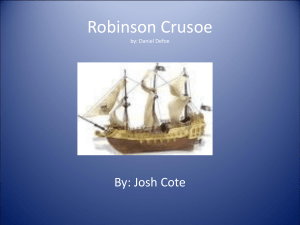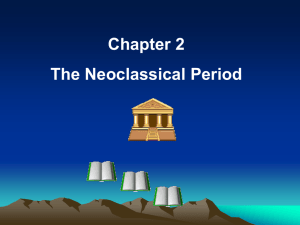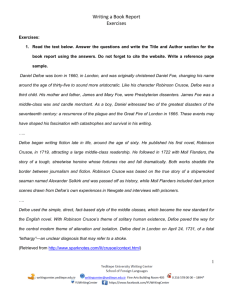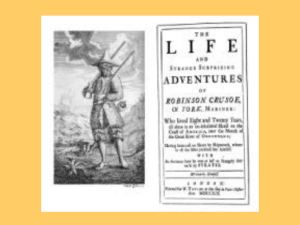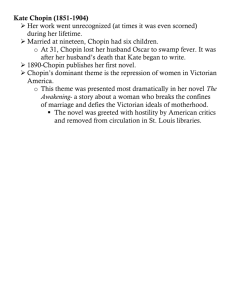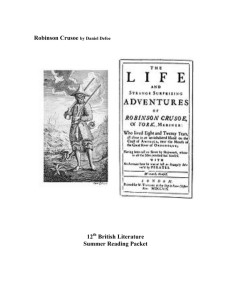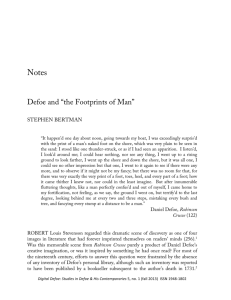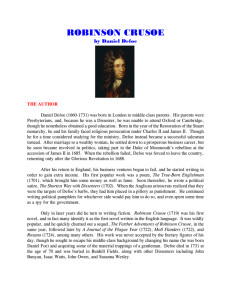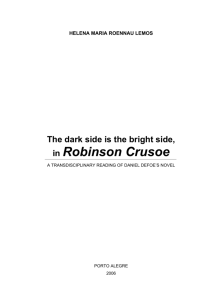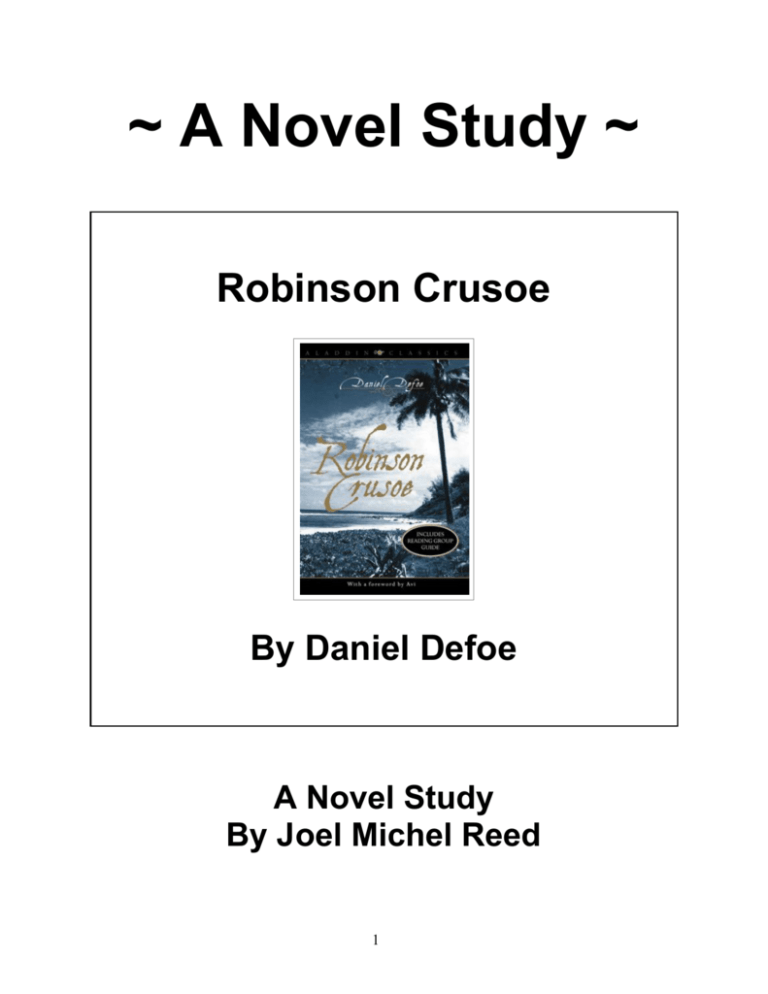
~ A Novel Study ~
Robinson Crusoe
By Daniel Defoe
A Novel Study
By Joel Michel Reed
1
Robinson Crusoe
By Daniel Defoe
Table of Contents
Suggestions and Expectations ..……………………………………….
3
List of Skills ….……………………………….…………………………..
4
Synopsis / Author Biography …..…………………………………......
5
Student Checklist ………………………………………………………..
6
Reproducible Student Booklet ..………………………………………..
7
Answer Key ...……………………………………………………………...
64
About the author: Joel Reed has over 50 published novel studies and is the coauthor of three fiction novels. For more information on his work and literature, please
visit the websites www.reedpublications.org and www.novelstudies.org.
Copyright © 2013 Joel Reed
All rights reserved by author.
Permission to copy for single classroom use only.
Electronic distribution limited to single classroom use only.
Not for public display.
2
Robinson Crusoe
By Daniel Defoe
Suggestions and Expectations
This curriculum unit can be used in a variety of ways. Each chapter of the novel study focuses on
three chapters of Robinson Crusoe and is comprised of five of the following different activities:
•
•
•
•
•
Before You Read
Vocabulary Building
Comprehension Questions
Language Activities
Extension Activities
Links with the Common Core Standards (U.S.)
Many of the activities included in this curriculum unit are supported by the Common Core
Standards. For instance the Reading Standards for Literature, Grade 5, makes reference to
a) determining the meaning of words and phrases. . . including figurative language;
b) explaining how a series of chapters fits together to provide the overall structure;
c) compare and contrast two characters;
d) determine how characters … respond to challenges;
e) drawing inferences from the text;
f) determining a theme of a story . . . and many others.
A principal expectation of the unit is that students will develop their skills in reading, writing,
listening and oral communication, as well as in reasoning and critical thinking. Students will also
be expected to provide clear answers to questions and well-constructed explanations. It is critical
as well that students be able to relate events and the feelings of characters to their own lives and
experiences and describe their own interpretation of a particular passage.
A strength of the unit is that students can work on the activities at their own pace. Every activity
need not be completed by all students. A portfolio cover is included (p.7) so that students may
organize their work and keep it all in one place. A Student Checklist is also included (p.6) so
that a record of completed work may be recorded.
Themes which may be taught in conjunction with the novel include perseverance when facing
difficult circumstances, friendship, tolerance, religion and faith.
Additional icons provided by http://robinweatherall.co.uk
3
Robinson Crusoe
By Daniel Defoe
List of Skills
Vocabulary Development
1. Locating descriptive words / phrases
2. Listing synonyms/homonyms
3. Identifying / creating alliteration
4. Use of capitals and punctuation
5. Identifying syllables
6. Identify anagrams
7. Identify personification
8.
9.
10.
11.
12.
13.
Use of singular / plural nouns
Listing compound words
Identifying parts of speech
Determining alphabetical order
Identification of root words
Identify/create similes
Setting Activities
1. Summarize the details of a setting
Plot Activities
1. Complete a time line of events
4. Identify cliffhangers
5. Identify the climax of the novel.
2. Identify conflict in the story
3. Complete Five W's Chart
Character Activities
1. Determine character traits
2. Relating personal experiences
Creative and Critical Thinking
1.
2.
3.
4.
Research
Write a newspaper story
Participate in a talk show
Conduct an interview
5. Write a description of personal feelings
6. Write a book review
7. Complete an Observation Sheet
Art Activities
1. A Storyboard
2. Create a collage
3. Create an Information Card
4. Design a cover for the novel
5. Create a comic strip
4
Robinson Crusoe
By Daniel Defoe
Synopsis
Who has not dreamed of life on an exotic isle, far away from civilization? Here is the
novel which inspired countless imaginations by lesser writers, none of which equal the power
and originality of Defoe's famous book. Robinson Crusoe, set ashore on an island after a terrible
storm at sea, is forced to make do with only a knife, some tobacco, and a pipe. He learns how to
build a canoe, make bread, and endure endless solitude. That is until, twenty-four years later,
when he confronts another human being. First published in 1719, Robinson Crusoe has been
praised by such writers as James Joyce, Virginia Woolf, and Samuel Johnson as one of the
greatest novels in the English language. (The Publisher)
A complete synopsis can be found here: http://en.wikipedia.org/wiki/Robinson_Crusoe
Author Biography
Daniel Defoe
Daniel Defoe (Born ca. 1660–1661, Died 24 April 1731)
Born Daniel Foe, was an English trader, writer, journalist,
pamphleteer and spy, now most famous for his novel
Robinson Crusoe. Defoe is notable for being one of the
earliest proponents of the novel, as he helped to popularize
the form in Britain, and, along with others such as Samuel
Richardson, is among the founders of the English Novel. A
prolific and versatile writer, he wrote more than 500 books,
pamphlets and journals on various topics (including politics,
crime, religion, marriage, psychology and the supernatural).
He was also a pioneer of economic journalism.
Courtesy of Wikipedia. http://en.wikipedia.org/wiki/Daniel_Defoe
5
Robinson Crusoe
By Daniel Defoe
Student Checklist
Student Name:
Assignment
Grade/Level
6
Comments
Robinson Crusoe
By Daniel Defoe
Name:
7
Robinson Crusoe
By Daniel Defoe
Chapter 1-3
Before you read the chapter:
If you were stranded alone on a desert island, what would be your first three priorities and why?
Vocabulary:
Choose a word from the list to complete each sentence.
contrary
discourse
called
forward
terrible
amazement
excellent
answer
1.
My father, a wise and grave man, gave me serious and ________ counsel against what he
foresaw was my design.
2.
I was sincerely affected with this __________, and, indeed, who could be otherwise?
3.
“A capful d’you call it?” said I; “’twas a _________ storm.”
4.
The sixth day of our being at sea we came into Yarmouth Roads; the wind having been
__________ and the weather calm, we had made but little way since the storm.
5.
By this time it blew a terrible storm indeed; and now I began to see terror and _________
in the faces even of the seamen themselves.
6.
Then all hands were _________ to the pump.
7.
My comrade, who had helped to harden me before, and who was the master’s son, was
now less __________ than I.
8.
We parted soon after; for I made him little _________, and I saw him no more.
8
Questions
Part 1 - Chapter 1
1.
What was Robinson describing when he said “... he had found, by long experience,
was the best state in the world, the most suited to human happiness, not exposed to
the miseries and hardships, the labour and sufferings of the mechanic part of
mankind, and not embarrassed with the pride, luxury, ambition, and envy ...”
2.
What promise did Robinson give his mother in order for him to receive a blessing
from his father to go out on his first voyage?
b.
What was the outcome of his request at the end of the chapter?
Part 2 – Chapter 2
1.
Describe the setting of chapter two.
2.
What kind of ship did Robinson say stood the best chance of surviving the storm?
3.
As the storm grew more violent, what did the Master, the Boatswain and many others
do that Robinson found to be rather sensible under the circumstances?
9
Part 3 - Chapter 3
1.
What famous Bible story did the master's son compare their dangerous voyage to, and
what were the reasons for this comparison?
b.
What was the master's son's advise to Robinson?
2.
What decision did Robinson's come to after thinking hard about his future?.
Language Activity
A.
There are many writers that enjoy using alliteration – a literary device is where the
author repeats the same sound at the beginning of several words. Here's an example of
an alliteration: “. . . screeching, screaming, shrieking about something or other."
Using your imagination, create your own examples of alliteration from the following
topics. Each example must contain a minimum of three words.
The sound of rain falling.
The sound of rustling leaves.
The sound of water flowing.
10
B. A simile is a comparison using the words “like” or “as”.
Here's an example from
chapter two: Now I saw plainly the goodness of his observations about the middle
station of life, how easy, how comfortably he had lived all his days, and never had been
exposed to tempests at sea or troubles on shore; and I resolved that I would, like a true
repenting prodigal, go home to my father. .”
What two things are being compared in this example?
Invent your own similes comparing the following items with something from your
own imagination:
a) A dog barking at a bird in a tree.
b) A farmer milking his cows.
C. Choose Wisely
If you were stranded on a desert island, and you could only bring three
items in your bag. Which items would you bring, and why?
1
2
3
11
Extension Activity
Storyboard
A storyboard is a series of pictures that tell about an important event in a story. A
storyboard can tell the story of only one scene – or the entire novel.
Complete the storyboard below illustrating the events described in the first 3 chapters of
Robinson Crusoe You may wish to practice on a separate piece of paper.
1
2
3
4
5
6
12

